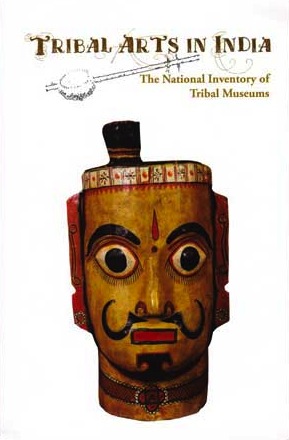Tips for using interactive maps
Toggle to normal view (from reader view) should the interactive map not be displayed by your tablet, smartphone or pc browser
For details and hyperlinks click on the rectangular button (left on the map’s header)
Scroll and click on one of the markers for information of special interest
Explore India’s tribal cultural heritage with the help of another interactive map >>
Depending on a museum’s own history, India’s tribal culture may be represented either by a specialized museum collection; or as part of departments such as anthropology or folk culture, arts and crafts.
To familiarize yourself with tribal culture in any part of India,
- click on any of the pins seen on the map
- zoom in and out on the map by clicking on the + / – control buttons
- for more options, click the square menu button on the left top of the map
- the map’s menu allows you to display or hide information by checking or unchecking any “layer”
- to hide the map’s menu, click the small triangle seen on its lower edge
- type “tribal museum”, “tribal art gallery”, “Adivasi museum”, “Santal museum”, or similar combinations of keywords, the name of a tribal community or a place name here >>
Note
On this website updates are readily found under two major categories:
India has far more museums and galleries with “tribal collections” than can be listed here. Smaller collections are rarely advertised in tourist brochures or on the internet yet accessible by appointment (e.g. anthropology departments and research institutions).
Find a Tribal Research Institute (TRI) in India >>
(up-to-date list on the TRI Portal of the Ministry of Tribal Affairs, Government of India)
Collections and documentations of musical instruments are also found in the premises of the Sangeet Natak Akademi (New Delhi), exhibitions at some of the Zonal Cultural Centres (Government of India), and in educational institutions across India (universities, colleges and music schools).
For current debates on the way tribal customs have been (mis)represented in and outside India, search the online editions of leading Indian newspapers, magazines and news portals.
As this map is constantly being updated, we welcome your suggestions on spreading the news on new or existing collections worth visiting.
Book recommendation
Tribal Arts in India: The National Inventory of Tribal Museums
“This Inventory, if not an exhaustive listing of the rich diversity of the materials, is nonetheless a definite invitation for researchers and institutions engaged in conservation of tribal culture for a future exploration.”
Available from Bhasha Research and Publication Centre www.bhasharesearch.org.in >>
For up-to-date information on any of the above places, persons or issues, use the search window seen here
Up-to-date reports by Indian journalists and commentators
To search Indian periodicals, magazines, web portals and other sources safely, click here. To find an Indian PhD thesis on a particular tribal community, region and related issues, click here >>
Search tips
Combine the name of any particular state, language or region with that of any tribal (Adivasi) community.
Add keywords of special interest (music, poetry, dance just as health, sacred grove and biodiversity); learn about the rights of Scheduled Tribes such as the “Forest Rights Act” (FRA); and the United Nations “Declaration on the Rights of Indigenous Peoples”, “Universal Declaration of Human Rights”, “women’s rights”, or “children’s right to education”.
Ask a question that includes “tribal” or “Adivasi”, for instance: “Adivasi way of life better?” (or “tribal way of life worse?”)
Specify any particular issue or news item (biodiversity, bonded labour and human trafficking, climate change, ecology, economic development, ethnobotany, ethnomedicine, global warming, hunter-gatherers in a particular region or state, prevention of rural poverty, water access).
For official figures include “scheduled tribe ST” along with a union state or region: e.g. “Chhattisgarh ST community”, “Himalayan tribe”, “Scheduled tribe Tamil Nadu census”, “ST Kerala census”, “Particularly Vulnerable Tribal Group Jharkhand”, “PVTG Rajasthan”, “Adivasi ST Kerala”, “Adibasi ST West Bengal” etc.
In case the Google Custom Search window is not displayed here try the following: (1) toggle between “Reader” and regular viewing; (2) in your browser’s Security settings select “Enable JavaScript” | More tips >>
Note: hyperlinks and quotes are meant for fact-checking and information purposes only | Disclaimer >>
Photo and video recommendation: a voice from rural India worth being heard
Whether you plan a visit or seek to learn more about India’s rural life – perhaps inspired by the Gandhian social movement or Rabindranath Tagore – explore “a living journal, a breathing archive” in the Adivasi category of PARI: the People’s Archive of Rural India initiated by distinguished photo journalist-turned-activist P. Sainath, continually enriched by stories from all over India.
“In less than 200 years, photography has gone from an expensive, complex process to an ordinary part of everyday life. From selfies to satellites, most of the technology we use and spaces we inhabit rely on cameras. […] While photographic documentation can aid in shaping history, it can also be a window into the horrors of the past.” – Read more or listen to Butterfly Effect 9 – The Camera on CBC Radio Spark 26 May 2023 >>

Tribal Arts in India | Worldcat.org >>
Free eBooks & Magazine by Bhasha Research and Publication Centre: Adivasi literature and languages >>
Learn more
Crafts and visual arts | Fashion and design | Masks
eBooks, eJournals & reports | eLearning
eBook | Background guide for education
Forest dwellers in early India – myths and ecology in historical perspective
Himalayan region: Biodiversity & Water
History | Hunter-gatherers | Indus Valley | Megalithic culture | Rock art
Languages and linguistic heritage
Modernity | Revival of traditions
Tribal Research and Training Institutes with Ethnographic museums